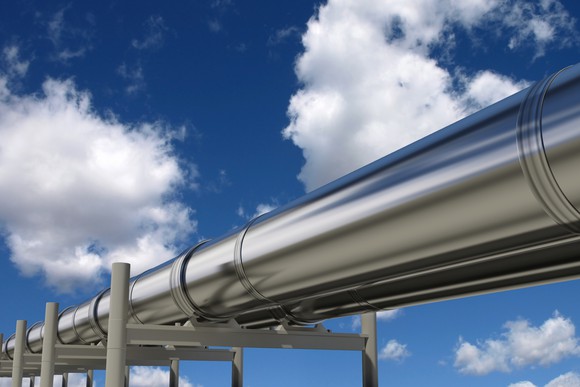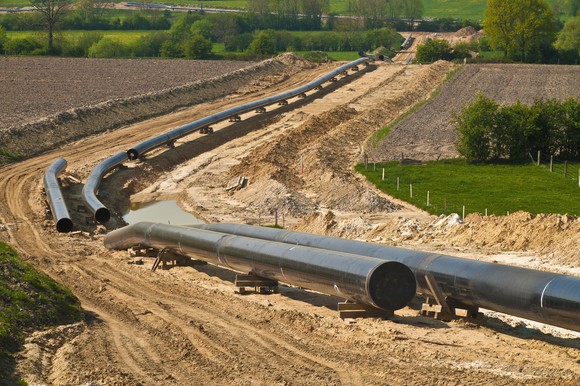Oil and gas production in the Permian Basin is up more than 50% since December 2016. While that high-octane growth rate has the country on pace to produce record-setting volumes this year, it has also caused some growing pains. Among them is that there isn't enough pipeline capacity to move all that oil and gas out of the region. Because of that, pipeline companies are building new infrastructure as fast as they can.
One of the many companies working to solve the Permian's pipeline problems is Summit Midstream Partners (SMLP +0.00%). The master limited partnership (MLP) is currently working on a long-haul pipeline that would transport natural gas from the northwest portion of the region to a major hub in Texas. The project would not only provide needle-moving growth for Summit -- and help support its sky-high 14.5%-yielding distribution -- but it could be a crucial supply link for the industry.

Image source: Getty Images.
Building a Permian footprint from scratch
Summit Midstream set up shop in the Permian last year when it signed an agreement to develop a natural gas gathering and processing system to support the growth of ExxonMobil (XOM +2.38%). The company is currently investing $110 million in building the Lane Plant, which will process 60 million cubic feet of natural gas per day (MMcf/d), as well as constructing some gathering pipelines to transport gas produced by ExxonMobil and some third-party customers to the plant. It's also building some additional lines to gather crude oil.
The company's initial footprint should serve as a springboard for future growth. For example, Summit could build additional oil handling infrastructure as well as pipelines to gather produced water. Furthermore, the company has the potential to expand the Lane Plant's capacity up to 600 MMcf/d in the future.
However, the largest project Summit has in development is the Double E pipeline, which could cost between $400 million to $450 million and move more than 1 Bcf/d of natural gas from the Lane Plant and other receipt points to an industry hub in Waha, Texas. Summit has already secured ExxonMobil as a foundational shipper for the project after the oil giant signed a long-term contract for half the pipeline's capacity. Exxon also has the option to acquire up to half the equity in the pipeline. While Summit still needs to secure shippers for the rest of the pipeline's planned capacity, the company noted that interest has been strong. That's no surprise since gas production in the Permian is on track to double over the next 10 years, which means producers need to secure space to move it out of the region. Summit hopes to lock up enough contracts to green-light the project by the end of the third quarter, which would put it on the path to finishing the pipeline in the second quarter of 2021.
It's an important project for Summit since it could move the needle for the $2.3 billion MLP. Assuming the company maintains a 50% stake and earns a similar return as its other Permian projects, it could boost Summit's earnings by around 9% from this year's level. That would go a long way in helping support or even potentially grow the company's high-yield payout in the coming years.

Image source: Getty Images.
An important piece of the puzzle
ExxonMobil's involvement in this project is worth noting since it increases the likelihood that Summit will move forward. That's because the Permian is crucial to Exxon's growth plan where it expects to expand output fivefold by 2025 as part of a broader strategy to boost production 25%.
Given the importance of the Permian to its growth strategy, Exxon has been locking up capacity on pipelines so that nothing hinders its ability to expand. That led it to sign up as an anchor shipper on Kinder Morgan's (KMI +1.22%) newest gas pipeline project, the Permian Highway Pipeline, which should start service at the end of 2020. Exxon committed to shipping up to 450,000 MMcf/d on the 2 Bcf/d pipeline that will transport gas from Waha to the Gulf Coast. That commitment, timeframe, and starting point suggest that Summit's Double E pipeline could be a crucial link to get Exxon's gas to the Permian Highway Pipeline.
The project could also be an important one to facilitate another pipeline that's under development. Targa Resources (TRGP +3.38%), MPLX (MPLX +0.89%), NextEra Energy, and private equity-backed WhiteWater Midstream recently announced that they're working on the Whistler Pipeline project, which would also move 2 Bcf/d from Waha to the Gulf Coast. The partners have already locked up gas supplies from a variety of sources, including from gas processing plants operated by Targa Resources as well as from the 1.4 Bcf/D Agua Blanca Pipeline, which is owned by a joint venture between Targa, MPLX, WPX Energy, and WhiteWater. However, the Whistler Pipeline's developers still need about 500,000 MMcf/d of additional volume commitments to fill its capacity, which could come from producers shipping on Double E.
The potential for a win-win solution
Summit Midstream is developing what appears to be a key natural gas pipeline project in the Permian Basin. Not only would Double E help get ExxonMobil's fast-growing production to Waha, where it could catch a ride on the Permian Highway Pipeline, but it could help supply the Whistler project as well. While the project meets those needs, it would fuel needle-moving growth for Summit. That's why investors should keep an eye on this proposed pipeline since it may very well be an important one for the region as well as for Summit Midstream Partners.
